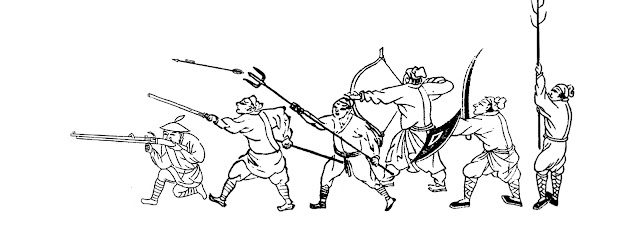After the conclusion of the campaign against Wokou (倭寇, Japanese coastal pirates), Qi Ji Guang spent some time as the deputy general of Shen Ji Ying (神機營) in Beijing, before being transferred to Ji garrison, taking charge of the training of the frontier troops from Ji, Changping and Baoding garrison. Despite having a much larger army under his command, all was not as well as it seemed — the command structure of the garrisons was chaotic and inefficient, military equipment and fortifications in disrepair, and the troops were undisciplined, unmotivated and lacked training.
Bu Ying (步營) and the new Mandarin Duck Formation
Qi Ji Guang realised that he was now commanding a completely new army, gained access to new equipment (while losing others) and most importantly, facing a completely new threat. Unlike the foot-slogging Wokou, the Mongols were a highly mobile mounted force, but had virtually no access to firearms. Qi Ji Guang modified the Mandarin Duck Formation accordingly, incorporating North China-specific equipment into the formation. Bu Ying (步營, foot regiment) formed the infantry branch of Qi Ji Guang's new army.
Dual role unit
As arquebus was relatively uncommon in North China, the frontier army under Qi Ji Guang's command did not have independent arquebusier unit (yet). Qi Ji Guang modified the Mandarin Duck squad to serve as dual role unit partly to compensate for this shortcoming, but mainly as an attempt to design a unit that could outshoot Mongol horse archers without sacrificing close combat capability.
Other blog posts in my Mandarin Duck Formation series:
Mi Zhan — the original Yuan Yang Zhen
Qi Ji Guang's Yuan Yang Zhen — Part 1
Qi Ji Guang's Yuan Yang Zhen — Part 2
Qi Ji Guang's Yuan Yang Zhen — Part 3
Qi Ji Guang's Yuan Yang Zhen — Part 4
Qi Ji Guang's Yuan Yang Zhen — Part 5
Qi Ji Guang's Yuan Yang Zhen — Part 6
Xu Guang Qi's Yuan Yang Wu


No comments:
Post a Comment